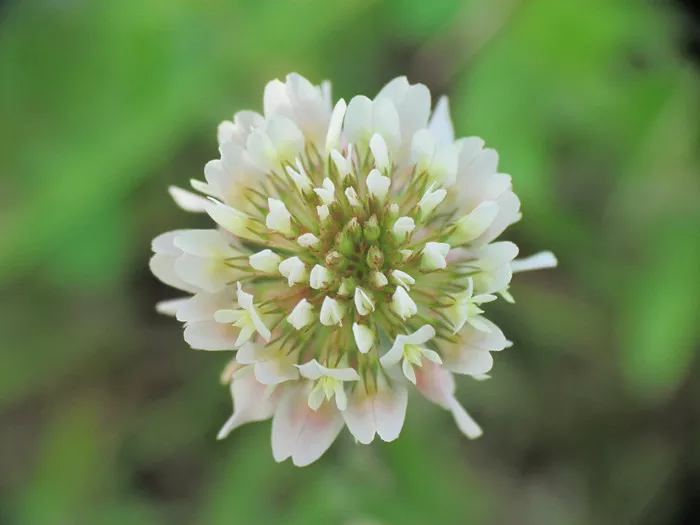White clover (Trifolium repens) is a common sight in many lawns and fields, often considered a weed by some but valued by others for its various uses. While most people are familiar with its presence, not many are aware of its potential edibility and nutritional value. In this article, we delve into the world of white clover flowers from three distinct perspectives: edibility, nutritional value, and recipes.
Edibility of White Clover Flowers
The question of whether white clover flowers are edible is a common one, especially considering their prevalence in outdoor spaces. While it’s essential to exercise caution and ensure proper identification before consuming any wild plant, white clover flowers are indeed edible and have been consumed by various cultures for centuries.
White clover flowers have a mild, slightly sweet flavor with hints of vanilla, making them a pleasant addition to salads, desserts, and beverages. However, it’s crucial to harvest them from areas free of pesticides and pollution. Additionally, avoid consuming flowers that appear wilted or discolored, as they may be past their prime or contaminated.
Before incorporating white clover flowers into your diet, it’s advisable to start with small quantities to gauge your body’s reaction, especially if you have allergies or sensitivities to similar plants. Some individuals may experience mild gastrointestinal discomfort, although allergic reactions are rare.
Nutritional Value of White Clover Flowers
Beyond their culinary appeal, white clover flowers offer a range of nutritional benefits. Like many edible flowers, they contain various vitamins, minerals, and phytonutrients that contribute to overall health and well-being.
White clover flowers are particularly rich in antioxidants, compounds that help combat oxidative stress and reduce the risk of chronic diseases. These antioxidants include flavonoids, phenolic compounds, and vitamin C, all of which play a role in supporting immune function and protecting cells from damage.
In addition to antioxidants, white clover flowers provide essential vitamins and minerals, including vitamin K, vitamin A, calcium, and magnesium. Vitamin K is crucial for blood clotting and bone health, while vitamin A supports vision, immune function, and skin health. Calcium and magnesium are essential for bone strength, muscle function, and nerve transmission.
Furthermore, white clover flowers contain dietary fiber, which promotes digestive health by supporting regularity and providing a feeling of fullness. Including them in your diet can contribute to a well-rounded intake of nutrients and support overall nutritional goals.
Recipes Featuring White Clover Flowers
Now that we’ve explored the edibility and nutritional value of white clover flowers, let’s dive into some creative ways to incorporate them into your culinary repertoire. From salads to beverages, there are numerous possibilities for enjoying the delicate flavor and nutritional benefits of these delightful blooms.
1. White Clover Flower Salad
Ingredients:
- Fresh white clover flowers
- Mixed salad greens (such as spinach, arugula, or lettuce)
- Cherry tomatoes, halved
- Cucumber, sliced
- Red onion, thinly sliced
- Feta cheese, crumbled
- Balsamic vinaigrette dressing
Instructions:
- Wash and dry the white clover flowers and mixed salad greens.
- In a large bowl, combine the salad greens, cherry tomatoes, cucumber, red onion, and crumbled feta cheese.
- Gently toss the salad with balsamic vinaigrette dressing until evenly coated.
- Garnish the salad with fresh white clover flowers before serving.
2. White Clover Infused Water
Ingredients:
- Fresh white clover flowers
- Filtered water
- Optional: Sliced cucumber, lemon slices, mint leaves
Instructions:
- Rinse the white clover flowers thoroughly and remove any stems or debris.
- Place the flowers in a large pitcher and fill it with filtered water.
- For added flavor, include sliced cucumber, lemon slices, or mint leaves.
- Refrigerate the infused water for at least an hour to allow the flavors to meld.
- Serve chilled over ice and garnish with additional white clover flowers, if desired.
3. White Clover Honey Butter
Ingredients:
- Fresh white clover flowers
- Unsalted butter, softened
- Honey
Instructions:
- Rinse the white clover flowers and pat them dry with a paper towel.
- In a small bowl, combine softened butter with a generous drizzle of honey.
- Finely chop the white clover flowers and stir them into the honey butter mixture.
- Transfer the flavored butter to a serving dish or shape it into a log using parchment paper.
- Chill the honey butter in the refrigerator until firm, then serve with freshly baked bread or muffins.
These are just a few examples of how you can incorporate white clover flowers into your culinary creations. Feel free to experiment with different recipes and methods to discover your favorite ways to enjoy these versatile blooms.
Conclusion
In conclusion, white clover flowers offer not only a delicate flavor but also a range of nutritional benefits, including antioxidants, vitamins, minerals, and dietary fiber. By understanding their edibility, nutritional value, and culinary potential, you can harness the power of these humble blooms to enhance your meals and support your overall health and well-being. So why not venture into your garden or nearby field and explore the culinary possibilities of white clover flowers today?


